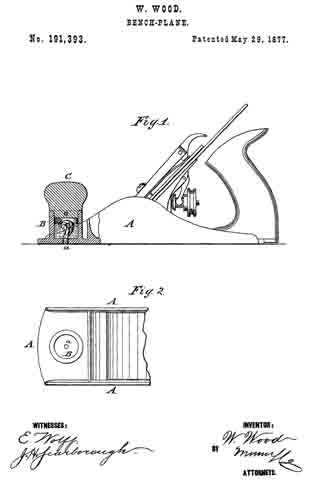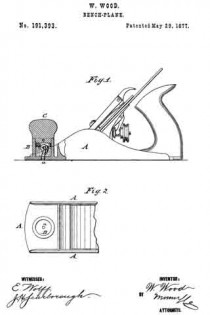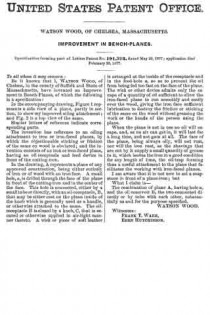No. 191,393 – Improvement In Bench-Planes (Watson Wood) (1877)

UNITED STATES PATENT OFFICE.
_________________
WATSON WOOD, OF CHELSEA, MASSACHUSETTS.
IMPROVEMENT IN BENCH-PLANES.
_________________
Specification forming part of Letters Patent No. 191,393, dated May 29, 1877; application filed February 26, 1877.
_________________
To all whom it may concern:
Be it known that 1, WATSON WOOD, of Chelsea, in the county of Suffolk and State of Massachusetts, have invented an Improvement in Bench-Planes, of which the following is a specification:
In the accompanying drawing, Figure 1 represents a side view of a plane, partly in section, to show my improved oiling attachment; and Fig. 2 is a top view of the same.
Similar letters of reference indicate corresponding parts.
The invention has reference to an oiling attachment to iron or iron-faced planes, by which the objectionable sticking or friction of the same on wood is obviated; and the invention consists of an iron or iron-faced plane, having an oil-receptacle and feed device in front of the cutting-iron.
In the drawing, A represents a plane of any approved construction, being either entirely of iron or of wood with an iron face. A small hole, a, is drilled through the face of the plane in front of the cutting-iron and in the center of the face. This hole is connected, either by a small tube or directly, with an oil-receptacle, B, that may be either cast on the plane inside of the knob which is generally used as a handle, or otherwise attached to the same. The oil-receptacle B is closed by a knob, G, that is secured or otherwise applied in air-tight manner thereto. A wick or piece of soft leather is arranged at the inside of the receptacle and in the feed-hole et, so as to prevent the oil from being fed too fast on the face of the plane. The wick or other device admits only the escape of a quantity of oil sufficient to allow the iron-faced plane to run smoothly and easily over the wood, giving the iron face sufficient lubrication to destroy the friction or sticking of the same on the wood without greasing the work or the hands of the person using the plane.
When the plane is not in use no oil will escape, and, as no air can get in, it will last for a long time, and not gum at all. The face of the plane, being always oily, will not rust, nor will the iron rust, as the shavings that are cut by it supply a small quantity of grease to it, which leaves the iron in a good condition for any length of time, the oil-trap forming thus a useful attachment to the plane that facilitates the working with iron-faced planes.
I am aware that it is not new to set a soap-stone in front of a plane-iron; but
What I claim is —
The combination of plane A, having hole a, and the oil-reservoir B, the two connected directly or by tube with each other, substantially as and for the purpose specified.
WATSON WOOD.
Witnesses:
FRANK T. WARE,
EBEN HUTCHINSON.


